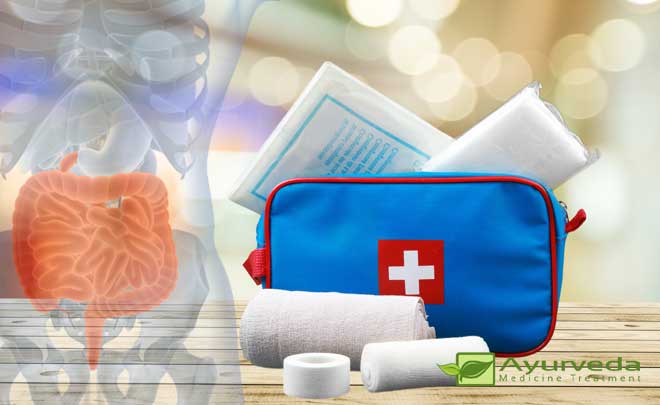
The Sprue Syndrome is known in Ayurveda as Grahani. Actually, this Ayurvedic term refers to the small intestine which stretches from the colon up to the duodenum. At times, the large intestine may also get affected by the Sprue syndrome.
As per Ayurvedic principles, the Sprue Syndrome attacks those people who have a psychic temperament. Such patients also possess the Paittika type of physical constitution.
Just like dysentery, the patient’s suffer from a gripping pain in the tummy.
Characteristics of Sprue Syndrome
The Sprue Syndrome is characterised by anaemia, weight loss, sore mouth, indigestion, frothy stools and diarrhoea. Besides, mucus appears in the patient’s stool. Significantly, the patients discharge a large amount of stool early in the morning after rising from bed.
Causes of the Sprue Syndrome
Tension or emotional distress is the primary cause of the Sprue Syndrome. Besides, it can be caused by any or a combination of the following factors: Anxiety, fear, nervousness, and worry anger.
Moreover, irregularity in taking food can aggravate the symptoms. On the other hand, indigestion can also lead to malnutrition. This occurs as the body tissues fail to get the required amount of nourishment. In the long run, the patient can suffer from anaemia and become rather weak insofar as his/her constitution is concerned. In such extreme cases, the patient will have to secure total medical attention. Simply refurbishing the menu won’t help.
Cure Constipation At The Initial Stages
Though such patients generally suffer from diarrhoea, many also report constipation while suffering from the Sprue syndrome. It is of utmost necessity that the patient takes care of constipation right at the initial stages. The patient should be given the husk of Isahagol.
The dose: Two teaspoonfuls of the Isahagol mixed with butter-milk need to be drunk at bedtime.
Dietary Regimen
- Pomegranate is one of the best natural items to contain the Sprue Syndrome.
- The patient should be quite choosy while consuming various types of vegetable.
- However, he/she should regularly take the following vegetable items: Pumpkin (only of the white variety), tomato, Karavellaka, Patola, drumstick, green banana and the also the banana flower.
- Such patients can be benefited if they regularly have rice mixed with butter-milk seasoned with a bit of salt.
- In fact, such people should consume butter-milk as much as he/she can.
- Actually, expedited recovery of the patient is possible if he/she stays only on butter-milk.
What Not To Eat
Vegetables: The patient should avoid taking the following vegetables: The red and yellow varieties of pumpkin, leafy items, lady’s finger, potato, colocasia, and any other vegetables that have a sleazy quality.
Non-vegetarian items: Similarly, the patients must totally quit meat and fish of all types.
Fruits: Don’t take dry fruits.
Other items: Spicy and fried and oily foods are contra-indicated in this condition.
Additional Important Points
- Quit anxiety, worry, anger, mental worry and other negative states of the mind.
- Don’t do activities which tire you physically. Over-exertion aggravates the condition.
- However, daily light exercises are a must.
- Practise the Yogic Pranayama (controlled breathing exercises) and meditation.
- Take sufficient rest.
- Sleep for at least an hour during the day-time.
- Ensure that the patient enjoys sufficient and sound sleep at nights.
Ayurvedic Treatment Sprue Syndrome
Ayurveda has two effective medications to cure the Sprue Syndrome. These are Jatiphaladi churna and Rasa parpati. The typically Ayurvedic method of administering Rasa parpati is known as Parpati kalpa.
Jatiphaladi Churna
Jatiphaladi churna is prepared from Jatiphala (nutmeg).
Preparation Mode: The kernel of the fruit is first crushed into the powdery form.
The dose: One teaspoonful of the powder thrice daily.
Rasa Parpati
Rasa parpati is recommended for patients suffering from the acute form of the Sprue syndrome. It is prepared from sulphur and mercury. Since these ingredients have toxic effects on the human body, both are first processed through a special Ayurvedic methodology. This method metamorphoses both the toxic substances into therapeutic medications.
Depending on the intensity of the Sprue Syndrome, the dose of Rasa parpati is gradually increased or decreased. This particular means of administering Rasa parpati is known as Parpati kalpa in Ayurveda.
The dose: Initially, the general dose of 125 gram is to be maintained for five days. Then the dose is daily increased by 65 gram till the level reaches 625 gram. This maximum level of the dose is to be consumed by the patient for 10 more days.
After that the dose is slowly reduced by 65 gram daily till the original level of 125 gram is attained. After that, the dose is discontinued.
Parpati Kalpa
Parpati kalpa is a rejuvenation therapy. It tones up the entire physique. Parpati kalpa also boosts the functioning capacity of the intestines. As a result, the patients experience increased appetite. The digestive process also successfully digests the augmented food items that are consumed to whet the appetite. Gradually, the positive effect is reflected in the increased weight of the patients.
Regimen During Parpati Kalpa
- The patient will have to strictly follow the following daily regimen while the Parpati kalpa process is in progress.
- This prescription requires strict dietary control. Hence, the therapy should be administered under the supervision of an Ayurvedic expert.
- The patient must not consume water or salt during the entire therapy roster.
- Nor should he/she bathe or use water even for sanitary purposes.
- Insofar as the patient’s diet is concerned, the person should be tendered only butter-milk or plain milk with a seasoning of sugar.
- It has been found that patients who were earlier not habituated to milk become habituated to this habit slowly but certainly. There are cases of patients unable to tolerate even 0.250 gram of milk daily subsequently digest up to 15 litres of milk during the therapy course.
- This increased capacity of the body to digest milk serves as the rejuvenation therapy.







Leave a Reply